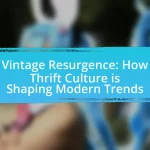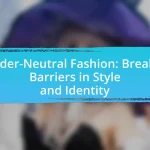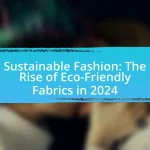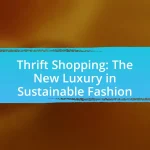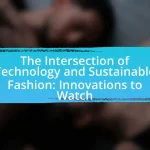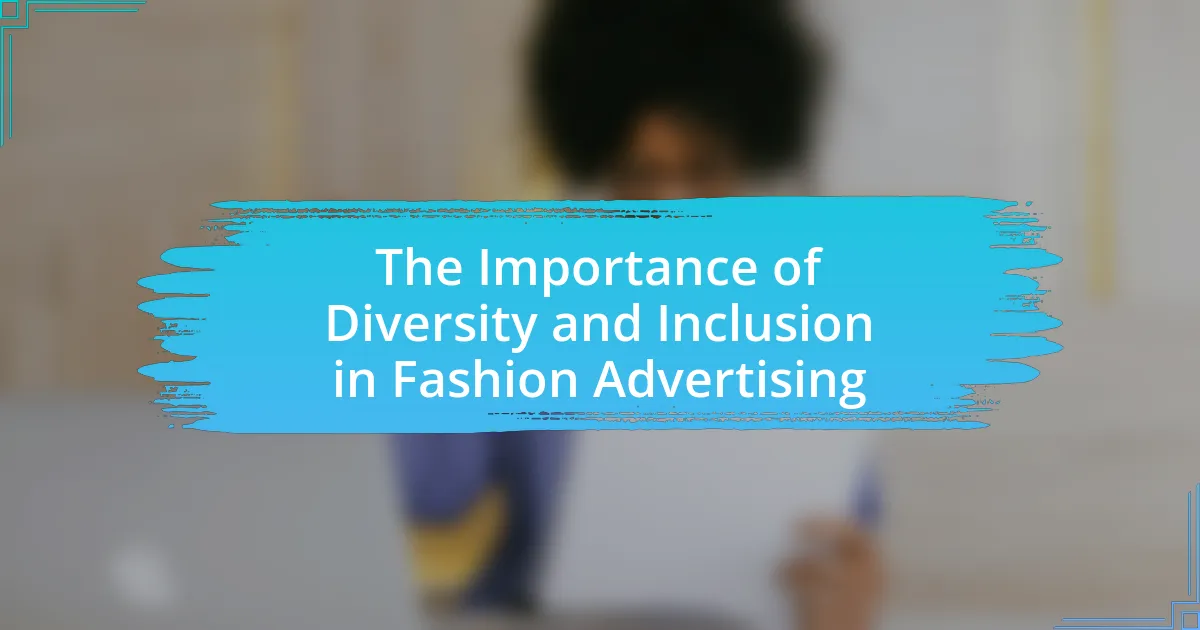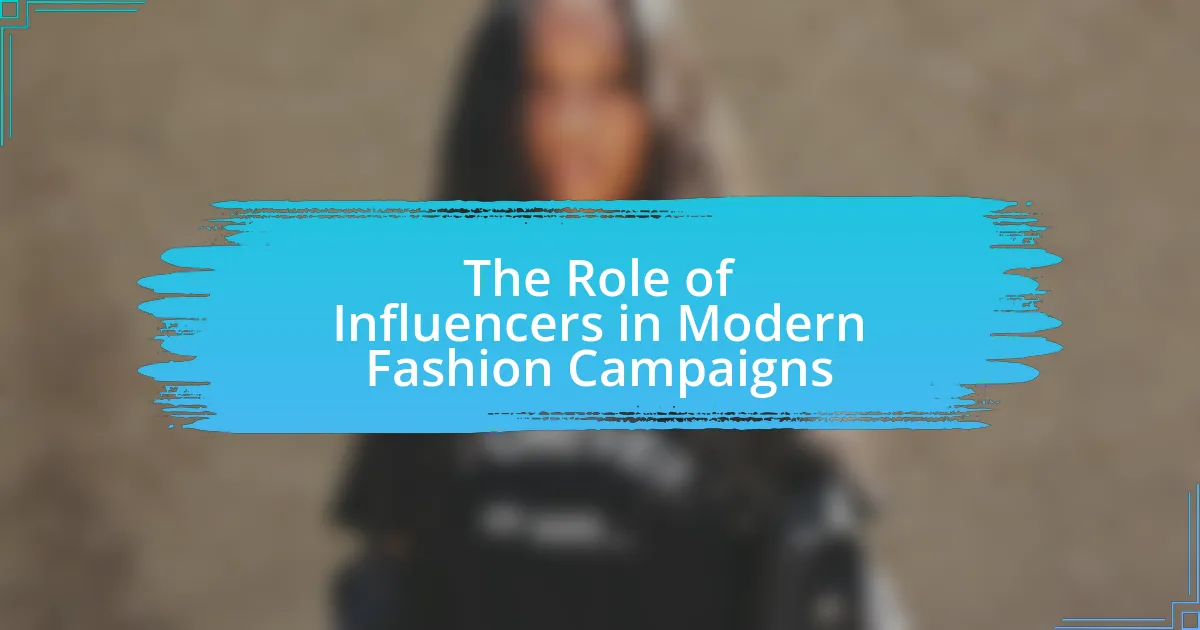The article examines the evolution of luxury fashion in a post-pandemic world, highlighting key shifts towards sustainability, digital engagement, and personal well-being. It discusses how consumer perceptions have changed, with a growing emphasis on eco-friendly practices and authentic brand values. The piece also explores significant changes in consumer behavior, including a preference for online shopping and experiential purchases, as well as the challenges luxury brands face, such as supply chain disruptions and increased competition. Additionally, it outlines strategies for brands to thrive in this evolving market, focusing on digital transformation and personalized consumer engagement.
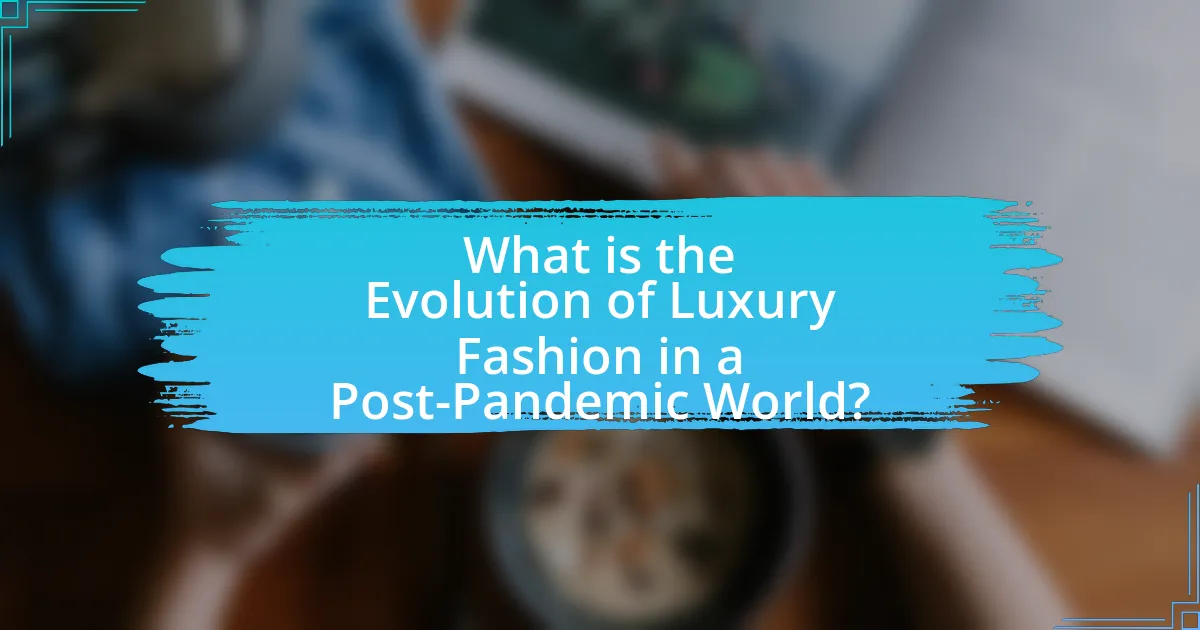
What is the Evolution of Luxury Fashion in a Post-Pandemic World?
The evolution of luxury fashion in a post-pandemic world has shifted towards sustainability, digital engagement, and a focus on personal well-being. Luxury brands are increasingly prioritizing eco-friendly materials and ethical production practices, responding to consumer demand for sustainability; for instance, a McKinsey report indicates that 67% of consumers consider sustainability when making luxury purchases. Additionally, the pandemic accelerated the digital transformation in luxury fashion, with brands enhancing their online presence and utilizing virtual experiences to connect with consumers, as evidenced by a 2021 Bain & Company study showing a 30% increase in online luxury sales. Furthermore, luxury fashion is now emphasizing comfort and versatility in designs, reflecting a change in consumer lifestyle preferences post-pandemic.
How has the pandemic reshaped consumer perceptions of luxury fashion?
The pandemic has significantly reshaped consumer perceptions of luxury fashion by prioritizing sustainability and authenticity over ostentation. As consumers faced economic uncertainty and reevaluated their values during lockdowns, there was a marked shift towards brands that demonstrate social responsibility and environmental consciousness. According to a McKinsey report, 67% of consumers now consider sustainability an important factor in their purchasing decisions, indicating a preference for luxury brands that align with these values. Additionally, the rise of digital engagement during the pandemic has led consumers to seek more meaningful connections with brands, favoring those that communicate transparency and authenticity. This shift reflects a broader trend where luxury is increasingly defined by quality and ethical practices rather than mere status symbols.
What changes in consumer behavior have emerged during and after the pandemic?
During and after the pandemic, significant changes in consumer behavior include a heightened focus on online shopping, increased demand for sustainable products, and a shift towards experiential purchases over material goods. The pandemic accelerated the adoption of e-commerce, with a report from McKinsey indicating that online shopping grew by 10 years in just three months during early 2020. Additionally, consumers have become more environmentally conscious, as evidenced by a survey from Deloitte showing that 32% of consumers are now more likely to purchase from brands that demonstrate sustainability. Lastly, there is a growing preference for experiences, with a study by Eventbrite revealing that 78% of millennials would rather spend money on experiences than on material items, reflecting a broader trend towards valuing experiences in the luxury market.
How have luxury brands adapted their marketing strategies in response to these changes?
Luxury brands have adapted their marketing strategies by increasing their focus on digital channels and enhancing customer engagement through personalized experiences. In response to the pandemic, brands like Gucci and Louis Vuitton shifted to online platforms, utilizing social media and e-commerce to reach consumers directly, resulting in a 50% increase in online sales for some brands during 2020. Additionally, luxury brands have embraced sustainability and inclusivity in their messaging, aligning with consumer values that have evolved during the pandemic, as evidenced by a 2021 McKinsey report indicating that 67% of consumers consider sustainability when making luxury purchases.
What are the key trends in luxury fashion post-pandemic?
Key trends in luxury fashion post-pandemic include a significant shift towards sustainability, digital transformation, and a focus on experiential luxury. Sustainability has become a priority, with brands like Gucci and Stella McCartney committing to eco-friendly practices and materials, reflecting consumer demand for responsible fashion. Digital transformation is evident as luxury brands enhance their online presence and e-commerce capabilities, with a 70% increase in online luxury sales reported by Bain & Company in 2021. Additionally, experiential luxury has gained traction, as consumers seek unique experiences over material goods, leading brands to offer personalized services and immersive events. These trends indicate a profound change in consumer behavior and brand strategies in the luxury fashion sector.
How has sustainability influenced luxury fashion brands?
Sustainability has significantly influenced luxury fashion brands by driving them to adopt eco-friendly practices and materials. This shift is evident as brands like Gucci and Stella McCartney have integrated sustainable sourcing, reducing waste, and promoting circular fashion. According to a 2021 McKinsey report, 67% of consumers consider sustainability when making luxury purchases, indicating a strong market demand for environmentally responsible products. Consequently, luxury brands are increasingly prioritizing transparency in their supply chains and investing in sustainable innovations, such as biodegradable fabrics and carbon-neutral production processes, to align with consumer expectations and enhance brand loyalty.
What role does digital transformation play in the evolution of luxury fashion?
Digital transformation is crucial in the evolution of luxury fashion as it enhances customer engagement and streamlines operations. Luxury brands are increasingly adopting digital technologies to create personalized shopping experiences, such as virtual try-ons and AI-driven recommendations, which cater to the evolving preferences of consumers. For instance, a report by McKinsey indicates that 70% of consumers are more likely to purchase from brands that offer personalized experiences. Additionally, digital platforms enable luxury brands to reach a global audience, expanding their market presence beyond traditional retail channels. This shift has been accelerated by the COVID-19 pandemic, which forced many luxury brands to pivot to e-commerce and digital marketing strategies to maintain sales and customer connections.
How has the definition of luxury changed in a post-pandemic context?
The definition of luxury has shifted in a post-pandemic context to emphasize authenticity, sustainability, and personal well-being over traditional markers of wealth. This change is driven by a growing consumer preference for brands that demonstrate social responsibility and environmental consciousness, as evidenced by a 2021 McKinsey report indicating that 67% of consumers consider sustainability when making luxury purchases. Additionally, the pandemic has heightened the value placed on experiences and emotional connections, leading consumers to seek luxury that enhances their quality of life rather than merely showcasing status.
What new values are consumers seeking in luxury fashion brands?
Consumers are increasingly seeking sustainability, authenticity, and inclusivity in luxury fashion brands. This shift reflects a growing awareness of environmental issues, with 66% of global consumers willing to pay more for sustainable brands, according to a 2021 Nielsen report. Additionally, authenticity is valued as consumers prefer brands that align with their personal values and demonstrate transparency in their practices. Inclusivity is also crucial, as brands that embrace diversity in their marketing and product offerings resonate more with consumers, particularly younger demographics. These new values are reshaping the luxury fashion landscape, driving brands to adapt and innovate.
How do experiences and personalization factor into the new luxury landscape?
Experiences and personalization are central to the new luxury landscape, as they enhance consumer engagement and foster brand loyalty. Luxury brands are increasingly focusing on creating unique, immersive experiences that resonate with individual preferences, reflecting a shift from traditional product-centric approaches to customer-centric strategies. For instance, a report by Bain & Company indicates that personalized experiences can drive a 10-30% increase in customer satisfaction and retention rates in the luxury sector. This trend is evident in practices such as bespoke services, exclusive events, and tailored marketing campaigns, which cater to the specific desires of affluent consumers, thereby redefining luxury in a post-pandemic world.
What challenges do luxury fashion brands face in the post-pandemic world?
Luxury fashion brands face significant challenges in the post-pandemic world, primarily including shifts in consumer behavior, supply chain disruptions, and increased competition from digital platforms. The pandemic has accelerated the trend towards online shopping, leading to a decline in foot traffic in physical stores, which luxury brands traditionally rely on for sales. According to McKinsey & Company, 65% of consumers have changed their shopping habits, favoring online purchases over in-store experiences. Additionally, supply chain issues have been exacerbated by global disruptions, leading to delays and increased costs for luxury brands. Furthermore, the rise of direct-to-consumer brands and digital-first luxury labels has intensified competition, forcing established luxury brands to adapt quickly to maintain market share.
How are supply chain disruptions impacting luxury fashion production?
Supply chain disruptions are significantly impacting luxury fashion production by causing delays, increasing costs, and limiting access to materials. These disruptions, primarily due to the COVID-19 pandemic, have led to factory shutdowns and transportation bottlenecks, which hinder the timely delivery of high-quality fabrics and components essential for luxury goods. For instance, a report by McKinsey & Company highlights that 75% of fashion executives experienced supply chain challenges during the pandemic, resulting in production slowdowns and inventory shortages. Consequently, luxury brands are forced to adapt by re-evaluating their sourcing strategies and increasing their reliance on local suppliers to mitigate risks associated with global supply chains.
What strategies are brands employing to overcome these challenges?
Brands are employing digital transformation and sustainability initiatives to overcome challenges in the luxury fashion sector. Digital transformation includes enhancing e-commerce platforms and utilizing social media for direct consumer engagement, which has become essential as online shopping surged during the pandemic. For instance, luxury brands like Gucci and Prada have significantly invested in their online presence, resulting in increased sales and customer interaction. Sustainability initiatives focus on ethical sourcing and eco-friendly production methods, responding to consumer demand for responsible fashion. Brands such as Stella McCartney have led the way by integrating sustainable practices into their business models, which not only attracts environmentally conscious consumers but also aligns with global sustainability goals. These strategies are proving effective in navigating the evolving landscape of luxury fashion post-pandemic.
How can luxury fashion brands thrive in the evolving market?
Luxury fashion brands can thrive in the evolving market by embracing digital transformation and sustainability. The shift towards online shopping accelerated during the pandemic, with e-commerce sales in the luxury sector increasing by 23% in 2020, according to Bain & Company. By investing in robust online platforms and enhancing customer experience through personalized services, luxury brands can capture a broader audience. Additionally, sustainability has become a critical factor for consumers, with 67% of luxury buyers indicating they prefer brands that demonstrate environmental responsibility. By integrating sustainable practices into their supply chains and product offerings, luxury fashion brands can align with consumer values and enhance brand loyalty.
What best practices should brands adopt to engage with consumers effectively?
Brands should adopt personalized communication strategies to engage with consumers effectively. Personalization enhances customer experience by tailoring messages and offers based on individual preferences and behaviors. Research indicates that 80% of consumers are more likely to make a purchase when brands offer personalized experiences. Additionally, leveraging social media platforms for authentic interactions fosters community and brand loyalty, as 54% of consumers prefer engaging with brands through social channels. Implementing these best practices not only increases consumer engagement but also drives sales and brand advocacy.
How can luxury brands leverage technology to enhance customer experiences?
Luxury brands can leverage technology to enhance customer experiences by implementing personalized digital interactions and utilizing data analytics. For instance, brands can use artificial intelligence to analyze customer preferences and behaviors, allowing for tailored recommendations and targeted marketing strategies. According to a McKinsey report, 71% of consumers expect companies to deliver personalized interactions, which can significantly increase customer satisfaction and loyalty. Additionally, augmented reality (AR) can provide immersive shopping experiences, enabling customers to visualize products in their own environment before making a purchase. This technology not only enhances engagement but also reduces return rates, as evidenced by a study from Shopify, which found that AR can increase conversion rates by up to 94%. By integrating these technologies, luxury brands can create a more engaging and customized shopping experience that meets the evolving expectations of consumers in a post-pandemic world.
What practical tips can luxury fashion consumers consider in a post-pandemic world?
Luxury fashion consumers can consider investing in timeless pieces that offer versatility and longevity. In a post-pandemic world, where sustainability and practicality have gained importance, selecting high-quality items that can be styled in multiple ways ensures value and reduces waste. According to a McKinsey report, 67% of consumers are more concerned about sustainability than before the pandemic, indicating a shift towards mindful purchasing. Additionally, consumers should prioritize brands that demonstrate ethical practices and transparency, as 60% of luxury shoppers are willing to pay more for sustainable products. This approach not only aligns with evolving consumer values but also supports the industry’s transition towards responsible fashion.
